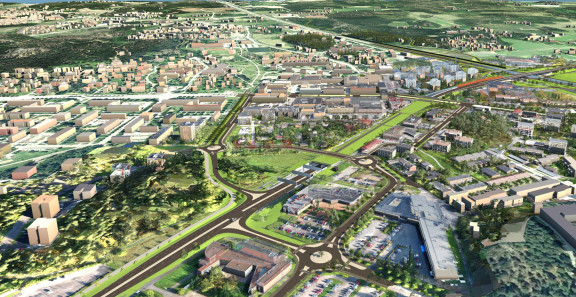
E18 part I: It all started with a competition
The planning of the E18 has over the decades involved practically every member of Sitowise’s infrastructure design team.

The planning of the E18 has over the decades involved practically every member of Sitowise’s infrastructure design team.
The planning of the E18 has over the decades involved practically every member of Sitowise’s infrastructure design team. The project is enormous and has, therefore, a special place in the team’s heart.
When the final motorway section on the E18 between Hamina and Vaalimaa opened for traffic this spring, this marked a historical milestone. Finland’s longest motorway was finally ready, after 62 years of construction.
The Finnish E18, which forms a part of the European Route 18 connecting Craigavon in Northern Ireland to St Petersburg in Russia, covers 1,890 km in Finland. Because the Finnish section is so close to the end point in St Petersburg, it has been considered a major undertaking throughout Europe.
By Finnish standards a mammoth project, the completion of the motorway took its time: it was built in stages with many hiatuses in between.
The E18 project, which will bring significant benefits to all road users, is the fruit of thousands of hours of planning and building, often overlapping. It is also part of Sitowise’s history.
Sitowise’s experts have contributed to the master planning and road planning for different sections of the motorway, in addition to conducing environmental impact assessments. They have been involved as geoplanners, bridge designers, pile slab designers, noise barrier designers, tunnel designers, environmental planners, lighting designers, traffic guidance experts and telematics designers. They were also part of the winning ideas competition team which launched the planning of the first western section of E18, and they have assisted in tendering and construction design and provided construction stage services. In one way or another, Sitowise has been integral to the E18 project from the beginning to its end. The final planning meetings were held in summer 2017.
Environmental considerations have been a major priority in the planning of the E18.
The western section quickly came to be symbolised by the adorable and vulnerable Siberian flying squirrel. The need to protect their nesting trees led to strong public and political resistance against the Lohja-Muurla motorway section.
Tapio Puurunen, the former CEO of Sito, remembers well the many concerns and reservations that not only environmentalists but also local residents and the general public were having regarding the building of the motorway.
To move forward with the project, the Road Administration decided to organise an invited planning competition. Invited to participate were three consultancy teams, one of which was formed by Sito (present-day Sitowise) and its favourite competitor, LT Consulting.
We joined forces to think what could be done to make the project more acceptable to the public. We created a matrix with all the interest groups and stakeholders that were in some way affected by the motorway, from farmers to environmentalists. All in all, we listed 15–20 interested parties. We then tried to come up with solutions that would address grievances from all these perspectives to make the motorway acceptable to all those concerned, and we created a table illustrating all these conditions,
Tapio Puurunen says.
It became one big table.
The Sitowise and LT Consultants proposal took an entirely new approach to respecting natural values and focused, among other things, on minimising noise pollution. The nesting trees of the Siberian flying squirrel were diverted, and the 51 km motorway section was to include seven tunnels. Some of them for the sake of the squirrels alone.
“While the new road alignment proved expensive, the negative impact of the motorway was effectively and successfully minimised,” Tapio Puurunen points out.
The final proposal was submitted under a pseudonym to ensure anonymity. The title of the proposal “Everybody wins” proved the winning concept.
The rest, as they say, is history.
Respecting environmental values and preserving the nesting trees of the Siberian flying squirrel became the hallmark of the E18. Environmental considerations were central to the building of the eastern section of the motorway was, too. The road runs near the coastline through a fragile natural landscape, some of which is protected as part of the Natura 2000 network.
The Koskenkylä–Kotka section was part of the Green Motorway concept, so it was built to strict environmental criteria.
Paavo Mero, Senior Consultant, says that the environmental impact assessment on the Loviisa–Kotka section of the E18, conducted in 1996–1998, was particularly challenging. “There are rivers that form a lifeline to the habitats, there are the Ahvenkoski rapids with its cultural and historical values, as well as cultivated fields that have landscape values of national importance.”
Sitowise has shown that building a motorway on the terms dictated by the Natura 2000 areas is possible. Even the habitat of the protected thick-shelled river mussel at Ahvenkoski and in the Langinkoski branch of the river was apparently successfully protected.
However, the motorway still presents a highly dangerous element to many wild animals. By proper planning and providing underpasses and bridges for animals help prevent animal road deaths. For example, between Koskenkylä and Kotka, there are under passes and five bridges 35 metres wide through which animals can safely cross the motorway.
Text: Dakota Lavento